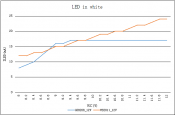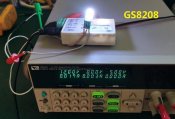hey guys, I found a new kind of pixel, and I do some test on it .It seems so interesting
Traditional 5V/12V smart pixels
5V smart pixels aren’t a good idea because they are non-uniform brightness. They can’t travel longer distance without further power requirements.
Therefore, a 12V + resistance smart pixels has been adopted. It is a bad idea to step down voltage from 12V source to 5V using resistor because the resistors will most likely burn up. The power dissipation is more than 5V smart pixels. 12V+R smart pixels can run more pixels together in a string without having to worry about voltage drop.
We can find the difference between voltage mode and current mode. The LED drive current change with VCC voltage for voltage control mode. So the brightness of LED will inevitably decline since it adopt voltage control mode. It should be only a temporary scheme.

New 12V smart pixels
At present, there are some new 12V smart pixel on the market. They adopt current mode LED control and do not use resistance voltage divider. When working under 12V source, the LED current is only 18mA. The new 12V smart pixels is uniform brightness with more pixels in a string.
Different structure comparison of two kinds of 12V smart pixels drive

We have tried to analyze the control mode of the new 12V smart pixel. Different from the 5V one, the new 12V smart pixel adopt series LED structure. Three LED RGB are connected in series with 12V power source. The current is only 18mA.

For this series LED structure, when only one light is on, such as red light, S1 is disconnected, S2 / S3 / S4 is closed, current flows from red light to S2 / S3 / S4, green light and blue light are turn off. The current is 18mA. When the LED is fully on, S1 / S2 / S3 is disconnected and S4 is closed. The current flows from red light to green light to blue light and then flows through S4. The current is still 18mA. If the LED is off, S4 is disconnected and there is no current in the circuit. This new 12V smart pixel connects RGB in series, and controls the LED on and off by the switch in parallel. In normal operation, the current of 12V structure is always 18mA, so there is no heating problem. When the light is white, the power efficiency is even higher than 5V smart pixels.

We compare all these smart pixels in the following data.
It was found that these new 12V smart pixel have made a lot of improvement compared with the traditional products. The data transmission also adopts the redundant data transmission mode or DMX512 mode. It is more reliable to be used.
Generally speaking, the new 12V smart pixel have nothing to do with voltage drop over distance if you have a long distance string. So the power supply can be placed further away from the LED, which is convenient for installation. I believe this new 12V smart pixel really offers a better choice.
Traditional 5V/12V smart pixels
5V smart pixels aren’t a good idea because they are non-uniform brightness. They can’t travel longer distance without further power requirements.
Therefore, a 12V + resistance smart pixels has been adopted. It is a bad idea to step down voltage from 12V source to 5V using resistor because the resistors will most likely burn up. The power dissipation is more than 5V smart pixels. 12V+R smart pixels can run more pixels together in a string without having to worry about voltage drop.
We can find the difference between voltage mode and current mode. The LED drive current change with VCC voltage for voltage control mode. So the brightness of LED will inevitably decline since it adopt voltage control mode. It should be only a temporary scheme.

New 12V smart pixels
At present, there are some new 12V smart pixel on the market. They adopt current mode LED control and do not use resistance voltage divider. When working under 12V source, the LED current is only 18mA. The new 12V smart pixels is uniform brightness with more pixels in a string.
Different structure comparison of two kinds of 12V smart pixels drive

We have tried to analyze the control mode of the new 12V smart pixel. Different from the 5V one, the new 12V smart pixel adopt series LED structure. Three LED RGB are connected in series with 12V power source. The current is only 18mA.

For this series LED structure, when only one light is on, such as red light, S1 is disconnected, S2 / S3 / S4 is closed, current flows from red light to S2 / S3 / S4, green light and blue light are turn off. The current is 18mA. When the LED is fully on, S1 / S2 / S3 is disconnected and S4 is closed. The current flows from red light to green light to blue light and then flows through S4. The current is still 18mA. If the LED is off, S4 is disconnected and there is no current in the circuit. This new 12V smart pixel connects RGB in series, and controls the LED on and off by the switch in parallel. In normal operation, the current of 12V structure is always 18mA, so there is no heating problem. When the light is white, the power efficiency is even higher than 5V smart pixels.

We compare all these smart pixels in the following data.
| 5V smart pixel | 12V smart pixel | New 12V smart pixel | ||
| Power supply | 5V | 12V | 12V | 12V |
| Drive IC | Ws2811 | Ws2811 | GS8512 | |
| LED control mode | Current mode | Voltage mode | Current mode | Current mode |
| LED current | 55mA | 24mA | 18mA | 18mA |
| LED dissipation | 115mW-275mW | 120mW-288mW | 216mW | 216mW |
| maximum efficiency | 53% | 22% | 66% | 66% |
| LED structure | parallel | parallel+R | series | series |
| Transmission protocol | Return to zero code | Return to zero code | redundant data transmission | DMX512 |
| Gray scale | 256 | 256 | 4096 | 65536 |
Generally speaking, the new 12V smart pixel have nothing to do with voltage drop over distance if you have a long distance string. So the power supply can be placed further away from the LED, which is convenient for installation. I believe this new 12V smart pixel really offers a better choice.
Attachments
Last edited:



